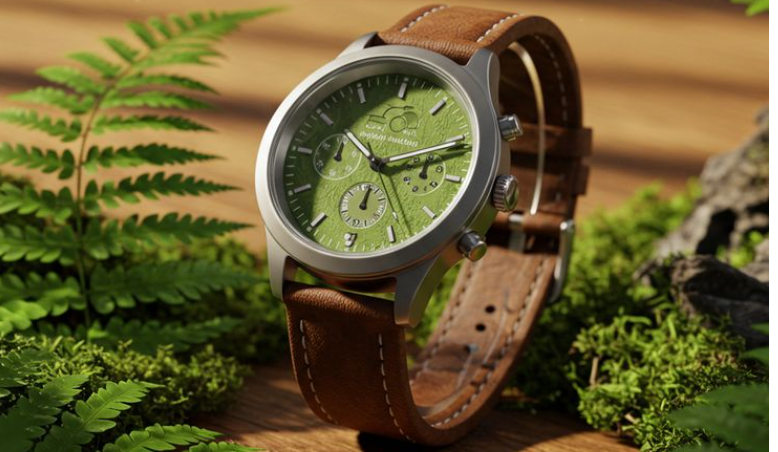
Watch Sustainability 2025: How Timepieces Went Green
Share
When you think of a luxury watch, you likely imagine gleaming steel, precious metals, and artisanal craftsmanship, not recycled plastic or mushroom leather. But in 2025, the fine balance between elegance and eco-consciousness is no longer a curiosity. It's a necessity. This year, the watch industry is undergoing a quiet revolution powered by sustainability, and it's telling a story as compelling as any mechanical marvel.
History of Sustainability in Watchmaking
The journey toward sustainability in watchmaking has been gradual but purposeful. Initially, eco-conscious efforts were limited to small gestures, biodegradable packaging or vegan leather straps, mostly driven by niche brands and environmentally aware consumers. Over the last decade, however, growing awareness of climate change and resource depletion pushed major players to rethink traditional manufacturing processes. Pioneers like Panerai began incorporating recycled metals and committing to carbon neutrality, while the industry started embracing traceability and ethical sourcing. This shift reflects a broader transformation, where sustainability evolved from a marketing buzzword to a fundamental pillar shaping design, production, and corporate responsibility.
Recycled Steel: The Building Blocks of a Greener Future
Sustainability begins not with straps or packaging, but with the metal beneath your wrist. Brands like Panerai , Chopard , and Pragma are pioneering steel sourced from recycled materials and forged in eco-friendly furnaces.
Panerai’s Luminor Marina “Verde Smeraldo” makes a statement with its eSteel® case , crafted from recycled alloy, as is Breitling’s Aquaracer and Omega’s new Aqua Terra. Chopard introduced Lucent Steel , an alloy containing 80% recycled content , aiming for 90% by 2025 . These metals aren’t inferior, they’re stronger, cleaner, and more sustainable.
But the newcomers are redefining it entirely. Meet Pragma , a Swiss microbrand founded by veterans of Rolex and F.P. Journe. Their debut, the P1 – Perseverance , features a 39 mm case made from 82.7% recycled solar steel , melted using solar-powered furnaces. Even the movement’s bridges are recycled titanium, and the Cordura strap, recycled nylon.
Beyond Steel: Straps, Gold, and Solar Power
Steel is the foundation, but sustainable innovation extends far beyond:
Straps : Brands like IWC and Nomos introduced vegan alternatives - Timbertex and Piñatex , while Panerai and Breitling rescue ocean plastic for NATO straps.
Traceable Gold and Diamonds : Breitling debuted a “traceable watch” featuring artisanal gold and lab-grown diamonds , each verified by blockchain tech.
Solar Movement Tech : Citizen , TAG Heuer , and Seiko continued to champion solar-powered movements , cutting battery waste and enhancing longevity.
This holistic approach, from strap to gold, signals that sustainability is no longer subordinate; it's a structural priority. Luxury is no longer just about time. It's about a legacy.
Pragma: An Underdog with a Mission
While established brands evolve, newcomers like Pragma stand apart. The P1 Perseverance isn't just a watch, it’s a manifesto.
Its unusual design, no logo, architectural indices, and rotating discs, sets it apart. But it's the transparency that turns heads. Customers can trace every material back to its origin: solar-steel cases from Panatere, recycled titanium bridges from Chronode, Cordura straps, and mushroom-based lining.
Priced around £22,000 (~$27,000), the P1 isn’t cheap, but that’s the point. You’re paying for the craftsmanship, the story, and the full ecological impact, documented and uncompromised .
The co-founders even offer fractional ownership, buyers of the limited gold edition receive equity, blending investment with environmental ideals.
The Role of Technology in Sustainable Watchmaking
Technology plays a pivotal role in accelerating sustainability in watchmaking. Blockchain, for example, ensures full traceability of gold, diamonds, and other precious materials, offering consumers transparency and peace of mind. Solar-powered movements, championed by Citizen and Seiko, reduce reliance on disposable batteries, enhancing longevity and reducing waste. Advanced manufacturing techniques, including 3D printing, optimize material usage and minimize scrap. Moreover, innovations in energy-efficient furnaces and renewable energy sources like solar power enable brands to reduce their carbon footprint significantly. Together, these technologies represent a fusion of tradition and innovation aimed at creating a more sustainable future.
Industry-wide Shifts: From Statements to Standards
This wave of sustainability isn’t isolated. Organizations like the Watch & Jewellery Initiative 2030 , backed by Cartier , Kering , and Chanel , are pushing for supply chain transparency and ethical sourcing at scale.
Breitling pledged only traceable gold from 2025 , while Panerai demonstrated early climate neutralism and brands like Ulysse Nardin experimented with fishing-net composite cases.
Even packaging has gotten the green treatment: Breitling now uses recycled PET boxes, and IWC and Oris have downsized packaging to reduce waste.
What This Means for You and the Industry
What does all of this mean for watch lovers? First, eco-consciousness is no longer niche, it’s mainstream luxury. Buyers today ask not just “What time is it?” but “How was this made?”
Second, sustainability is becoming synonymous with quality and exclusivity. Pragma’s meticulous sourcing and recycled materials don’t diminish its cachet, they enhance it.
Finally, the industry is evolving, from reactive recycling to proactive design. Modular straps, energy-efficient production, traceable gems, all signal that the watch world is not just keeping time, but keeping green.
FAQ
Q: Which watch is the most recycled currently available?
A: Panerai’s eLAB‑ID was 98.6% recycled, but Pragma’s P1 Perseverance leads at 82.7% recycled solar steel in a production model.
Q: Are lab-grown diamonds accepted in luxury watches?
A: Yes. Breitling launched the Super Chronomat Origins using traceable artisanal gold and lab-grown diamonds, authenticated via blockchain.
Q: What’s “solar stainless steel”?
A: It’s recycled steel melted in solar-powered furnaces by Panatere, used in Pragma’s P1 case, drastically reducing its carbon footprint .
Q: Will sustainable materials affect watch durability?
A: Not at all. Recycled alloys match or outperform virgin material. The solar steel used by Pragma, Panerai, and others offers the same strength and finish, all backed by rigorous testing.
The Future of Watchmaking Is Circular, Not Disposable
What began as small gestures, eco-friendly straps, lab-grown metals, and recycled packaging, has now surged into a powerful movement sweeping across the watch industry. By 2025, sustainability is no longer a marketing buzzword or an optional feature. It is an integral part of the entire lifecycle of a timepiece, from raw material sourcing to manufacturing, and ultimately to the hands of the wearer. This transformation demands transparency, rigorous processes, and a genuine commitment to reducing environmental impact. The luxury watch world is embracing these challenges not just to stay relevant but to lead the way into a more responsible future.
As consumers become more informed and discerning, the question is no longer just “What time is it?” but “How was this watch made?” The provenance of every component, from recycled steel forged in solar-powered furnaces to vegan straps crafted from innovative materials, matters deeply. Packaging, too, has evolved, moving towards minimalism and recyclability. This shift reflects a growing awareness that owning a watch today is not just a personal statement of style and taste, but a conscious choice with planetary implications.
In this new era, timekeeping transcends the traditional role of measuring moments; it becomes a symbol of stewardship, legacy, and respect for our planet’s finite resources. Each watch tells a story, not just of craftsmanship and heritage, but of innovation, responsibility, and hope. As you glance at the time on your wrist, remember that you’re wearing more than just a beautiful object, you’re wearing a commitment to a sustainable future, where luxury and ecology coexist in harmony.
The future of watchmaking is circular, conscious, and collaborative. It’s a future where every tick of the second hand resonates with care for the environment and a promise to the generations to come. This is more than evolution, it’s a revolution, and it’s already here. Watch sustainability
Time to Choose Better
Inspired by the future of sustainable watchmaking? Explore eco-conscious, expertly crafted timepieces that make a difference , in style and in impact.
Shop the latest sustainable luxury watches at JD Watches today. Because time shouldn’t cost the Earth.



